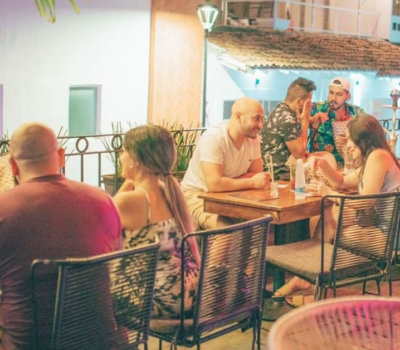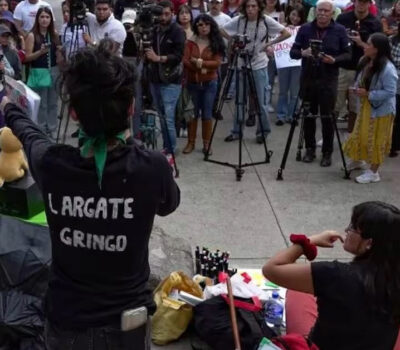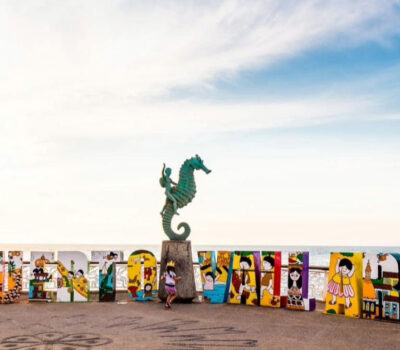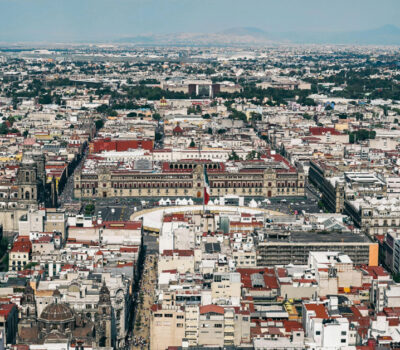I’m staring at the face of Mexico, literally. Five hundred faces, in fact. The owner of Casa de la Cuesta in San Miguel de Allende explains how his collection of Mexican ceremonial masks so overflowed his bed-and-breakfast, he opened a Mask Museum next door.
Grotesque horned faces, whose wigs were made from horse hair or cow tails, are worn in dances of the Tastoanes in the state of Jalisco to depict the struggle of native peoples against Spanish conquistadors, represented by Santiago (St. James), Spain’s patron saint, he says. Gentle faces of Mary, Joseph and angels, and frightening devil masks were worn in plays introduced by Spanish missionaries introduced to illustrate the battle between good and evil and stories from the Catholic calendar.
“It started as a hobby, turned into a passion, and became an addiction for which there is no known cure,” says Bill LeVasseur of his mask obsession. “In indigenous cultures in Meso-America, there was no concept of the devil. Everything was duality.”
Some masks still adorn guest rooms in his B&B — “not the scary ones,” he says with a smile — while 500 more are in storage, says LeVasseur. Years before being a “Mask Man” and ethnograper who’s lectured on Mexican masks and mankind’s 30,000-year masking traditions at universities, he was a “Mad Man,” in advertising in New York.
About 10,000 or so Americans and Canadians live in San Miguel de Allende, a Spanish Colonial city famed as an art colony and declared a National Historic Monument in 1926. Many are retirees who have opened shops, galleries, inns and restaurants in San Miguel. Luckily, the expatriates I met, like the Casa de la Cuesta owner, have fallen in love with Mexico’s cultural heritage.
The color palette of San Miguel is vibrant, cayenne, cinnamon, pumpkin, rose and goldenrod, and many splendidly preserved 300-year-old buildings line the cobblestone streets. Bougainvillea in purple, magenta, pink and salmon grows profusely, and many carved stone fountains on street corners lend grace and charm. Lush greenery abounds in this city in the state of Guanajuato, especially in its Jardin, the town hub from 1732, and Parque Juarez.
Near Parque Juarez, in Casa de Liza B&B, my cozy corner suite is crammed with Mexican folk art and antiques, while orange floral-painted bookshelves overflow with dozens of books on Mexican, Spanish and Moroccan design and Mexico guidebooks. A chest depicts the culture clash of Mexico: a pale European-looking man playing a stringed instrument serenades a dark-skinned woman clad in a long vivid Mexican-style dress, surrounded by mountains and banana trees. A chair is shaped like a butterfly, and Mexican tiles adorn my bathroom in this former 18th-century hacienda, whose rooms are dispersed in small terra cotta-colored buildings amid patios and gardens.
In sharp contrast, contemporary art by mostly Latin America artists is on display at Hotel Matilda, a new luxury boutique hotel whose hip vibe reminds me of W Hotels I’ve seen. Its spin on Mexican tiles is an installation of a dozen digital screens in varied patterns projected on the wall behind the white lobby’s front desk, by Mexican artist Nacho Rodriguez Bach.
Behind the pumpkin-colored street wall, you’ll find an infinity pool, spa and gourmet restaurant from a top Mexican celebrity chef. The hotel was named in honor of the American developer’s mother, New Orleans heiress Matilda Gray Stream. The one noncontemporary artwork is a painting of the young debutante as Diana, goddess of the hunt, by Diego Rivera.
After hearing the identity of the owner’s mother, I remember with a shock I’ve passed her mansion in the French Quarter many times, a few blocks from my home when I lived there. A few months after my visit to San Miguel, I actually met Matilda Stream, who says she’s just back from the wedding of the daughter of the Maharajah of Udaipur, India, a friend of hers. It’s a revelation so jaw-dropping, I pause before complimenting her on her son’s hotel.
At Galeria Atotonilco (FolkArtSanMiguel.com), a gallery just outside San Miguel, I found a treasure trove of Mexican folk art, from fanciful Oaxacan animals, Jalisco pottery, dance masks, wood carvings, inlaid boxes and paintings to serapes and textiles. No surprise: TripAdvisor called it the No. 1 shopping destination in San Miguel.
The owner turned out to be Mayer Shacter, a former Bay Area ceramicist and shop owner. A ceramic artist for 27 years whose work is in the collections of the city of San Francisco, Oakland Museum, director John Huston and singer Ella Fitzgerald, Shacter opened a midcentury-modern furniture and decorative arts store in Oakland in 1999, Think Modern.
At Galeria Atotonilco, which he opened in 2006, Shacter takes pride in finding artisans who “keep alive one of the richest traditions of indigenous art anywhere on the planet.”
His wife, Susan Page, runs the annual San Miguel Writers Conference each February. It’s one of many cultural activities in San Miguel, which include an annual jazz and blues festival, Baroque music festival, and frequent art classes and shows, lectures and film screenings.
At sunset, when the sky is tinged in shades that match the city’s palette, I found a rooftop terrace to admire a breathtaking view of San Miguel’s steeple-studded skyline and the pink ornately carved stone facade of its main church, La Parroquia de San Miguel de Arcangel. At night, the church is brilliantly illuminated.
For information, see AllendeMexico.com.
I’m staring at the face of Mexico, literally. Five hundred faces, in fact. The owner of Casa de la Cuesta in San Miguel de . . .











